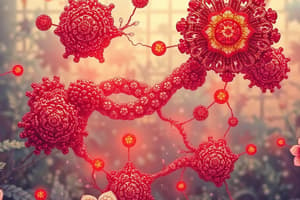Podcast
Questions and Answers
What is the primary role of enzymes in catalysis?
What is the primary role of enzymes in catalysis?
- To provide an alternative route with a higher activation energy barrier
- To slow down chemical reactions
- To provide an alternative route with a lower activation energy barrier (correct)
- To increase the activation energy barrier
Why is catalysis crucial for maintaining biological processes?
Why is catalysis crucial for maintaining biological processes?
- It prevents reactions from proceeding in the desired direction
- It ensures that reactions proceed in the desired direction (correct)
- It ensures that reactions occur more slowly and inefficiently
- It has no significant impact on biological processes
What is the term used to describe the process of enzymes accelerating chemical reactions?
What is the term used to describe the process of enzymes accelerating chemical reactions?
- Hydrolysis
- Biochemical reactions
- Enzymatic reactions
- Catalysis (correct)
What is the characteristic of enzymes that enables them to act as catalysts?
What is the characteristic of enzymes that enables them to act as catalysts?
What is the primary function of enzymes in biological reactions?
What is the primary function of enzymes in biological reactions?
What is the primary function of enzymes in biological reactions?
What is the primary function of enzymes in biological reactions?
What is the term for the process of breaking down food molecules into their building blocks outside of cells?
What is the term for the process of breaking down food molecules into their building blocks outside of cells?
What is the suffix added to the root name of the substance being acted upon to form an enzyme's name?
What is the suffix added to the root name of the substance being acted upon to form an enzyme's name?
What is the role of the active site in an enzyme's structure?
What is the role of the active site in an enzyme's structure?
What type of enzymes are responsible for energy release in muscular contraction?
What type of enzymes are responsible for energy release in muscular contraction?
What is the classification of enzymes based on?
What is the classification of enzymes based on?
Flashcards are hidden until you start studying
Study Notes
Enzymes and Catalysis
Enzymes are globular proteins that regulate biological reactions by speeding up the breakdown of food molecules into their respective building blocks. These reactions occur outside of the cells lining the gut, a process known as hydrolysis. Enzymes are named using two systems: the suffix '-ase' is added to the root name of the substance being acted upon, and the type of chemical reaction the enzyme catalyzes. For example, the enzyme that digests sucrose is called sucrase, and it belongs to the hydrolase class, which involves adding a water molecule to break a chemical bond.
The chemical structure of enzymes consists of a protein molecule with a specific three-dimensional shape. This shape includes an active site that attracts other molecules with a complementary shape, similar to a key fitting into a lock. The enzyme acts as the lock, the attracted molecule (known as the substrate) is the key, and once the chemical reaction within the lock and key arrangement has been completed, the products are released, and the enzyme is free to attract another substrate molecule.
Enzymes are classified according to the type of chemical reaction they catalyze. For instance, hydrolases, such as digestive enzymes, are involved in breaking down large food molecules into smaller components, while oxidation-reduction enzymes, like hydrogenases and dehydrogenases, are responsible for energy release in muscular contraction.
Catalysis, the process by which enzymes accelerate chemical reactions, is of significant importance in understanding the role of enzymes in biological systems. Enzymes facilitate reactions by providing an alternative route with a lower activation energy barrier, allowing reactions to occur more quickly and efficiently than they would without the enzyme's presence. This is crucial for maintaining the equilibrium of various biological processes, as it ensures that reactions proceed in the desired direction.
In summary, enzymes are globular proteins that play a vital role in biological reactions by speeding up the breakdown of complex molecules into their building blocks through the process of hydrolysis. They are classified based on the type of chemical reaction they catalyze, and their unique structure allows them to act as catalysts by lowering the activation energy barrier for various reactions, enabling them to proceed more quickly and efficiently.
Studying That Suits You
Use AI to generate personalized quizzes and flashcards to suit your learning preferences.




